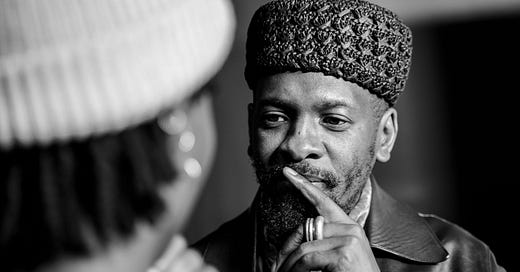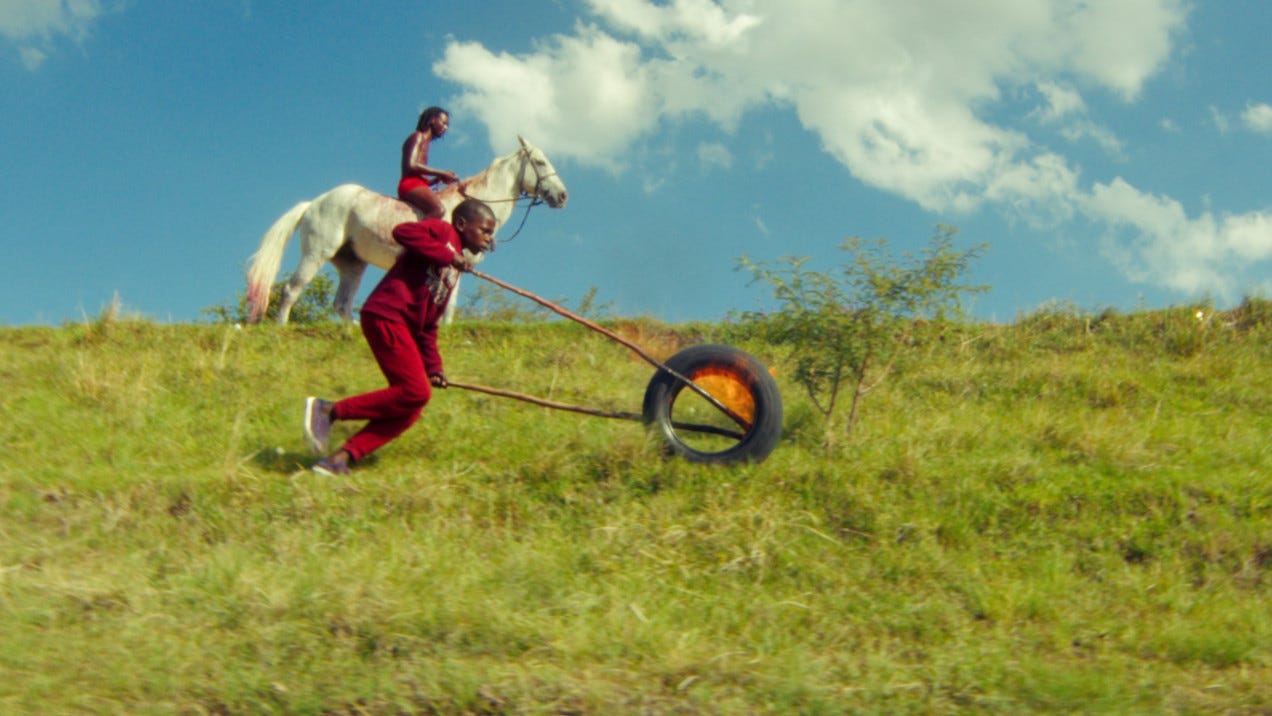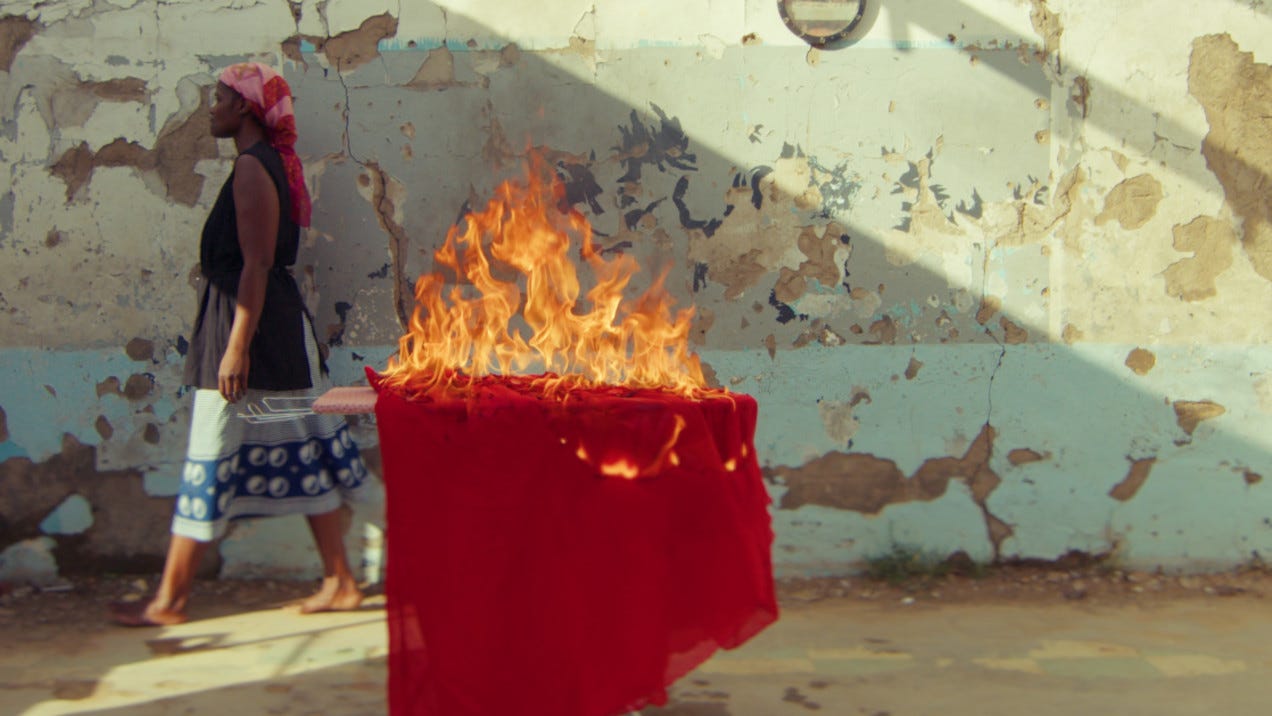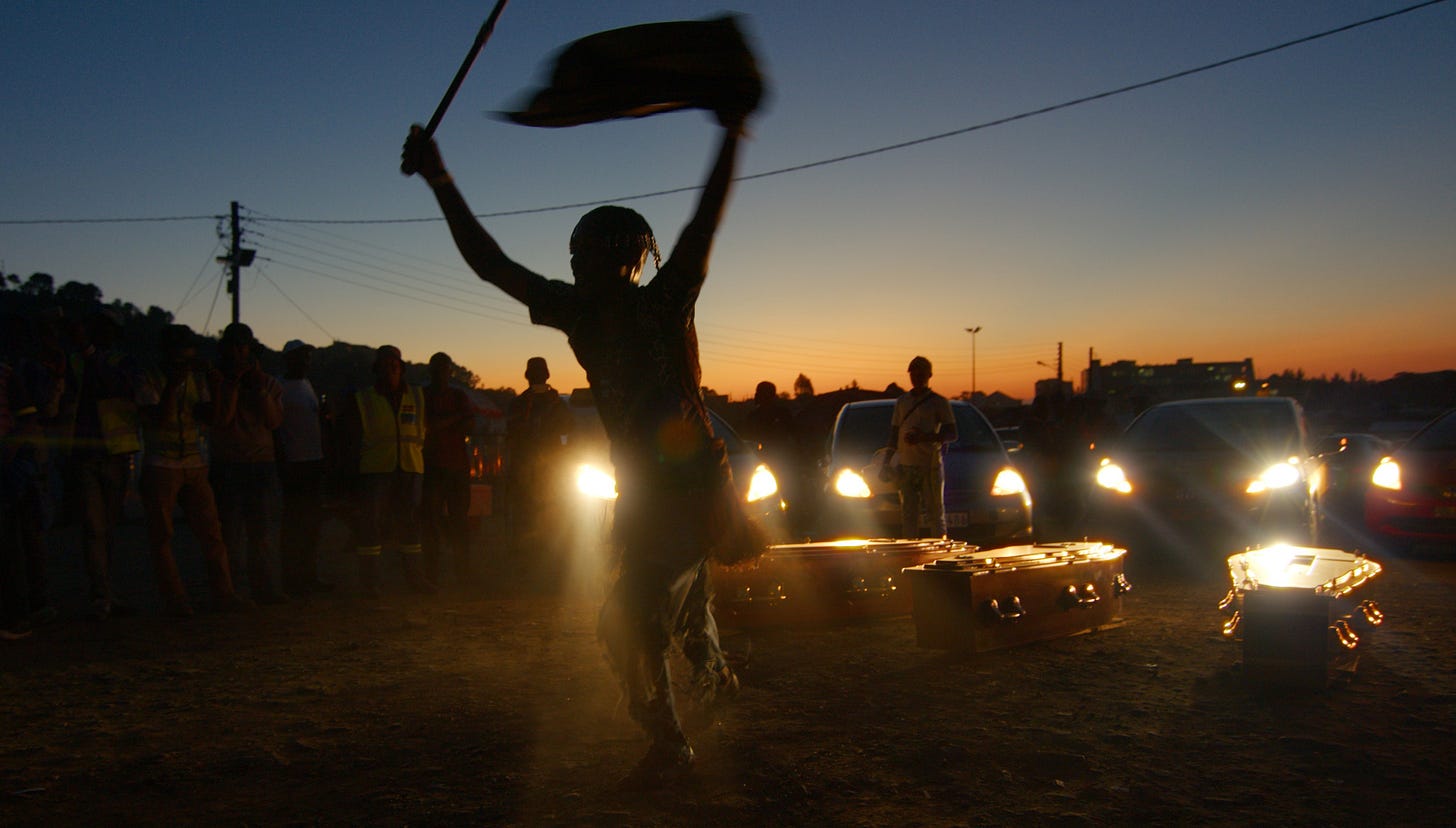Film Show 050: Lemohang Jeremiah Mosese
An interview with the Mosotho filmmaker about vomiting out his stories, the importance of imagination, and his new film 'Ancestral Visions of the Future'
Lemohang Jeremiah Mosese (b. 1980) is a Mosotho filmmaker who has spent his career crafting poetic movies about identity, landscape, and collective memory. Born in Hlotse and now based in Berlin, Mosese gained international acclaim with the release of Mother, I Am Suffocating. This is My Last Film About You. (2019) and This Is Not a Burial, It’s a Resurrection (2019). Self-taught, his works employ a form of storytelling that is characteristic of what he experienced while growing up in Lesotho, including the vibrant anecdotes he heard from his mother and the recreation of films in his classrooms. His newest work is Ancestral Visions of the Future (2025), a dreamlike portrait of childhood, place, and community. The film screens as part of this year’s Cinéma du Réel—more information can be found here. Joshua Minsoo Kim spoke with Mosese on February 16th, 2025 via Zoom to discuss his new film, how he approaches sound, and the importance of imagination.
Joshua Minsoo Kim: How’s your day been?
Lemohang Jeremiah Mosese: Today was very relaxed. The last few days have been hectic as I’ve been putting the final touches on my film.
Is there anything in particular that you always end up doing last with a film?
Yeah—letting go. Once you get closer to the date of a screening, your eyes become a magnifying glass. I’ll look over the [onscreen] text in the film and think, “Oh, I could’ve done things this other way.” But I have a team who conspires against me to make sure I don’t keep doing this (laughter). I managed to squeeze a few things in, though. It was almost like I was preparing to watch it myself. I know that if there are things that’ll bug me, I won’t want to watch it. And it normally takes me three years until I can watch one of my movies with other people.
In previous interviews, you’ve mentioned your love for the composer Julius Eastman. He’s talked about how he loves improvisation because it allows for an instant expression of feelings. And in participating in improvisation, he says that he is in the act of “seeing himself.” I was thinking of this while watching Ancestral Visions of the Future (2025) and while revisiting your old works. In previous interviews you’ve talked about how you don’t try to come up with a meaning for your films before making them but are instead content with letting meanings arise after the films are made. Does what Eastman say about improvisation resonate with you at all with regards to your approach to filmmaking?
Yeah, it makes sense. I create works based on feelings. Speaking of Julius Eastman, I was listening to him a lot, especially the score he did for The Holy Presence of Joan d'Arc. In my previous works, the sound guy I worked with didn’t approach things from a technical point of view. The techniques came after, when we had to rectify something. And this is the same with my ideas; I don’t know where they’re going, but there’s a drive for this picture I have and I work my way into it. That’s why I like this essayistic, allegorical form—they allow for these accidents to happen, they allow you to go with your feelings without questioning it. I didn’t go to film school, so this is the only way I know how to make films. I’ve never been on a film set other than my own. I don’t even know how other people direct! (laughter). I try not to be so hard on myself, and it’s rewarding when it translates. You always have to check yourself—is this only affecting for me? But I’ve allowed myself to be free when creating.
Over the course of your career, have you done things to not be so hard on yourself? Has this changed at all, or did it simply come with time?
When I was a kid, the only currency I had was my imagination. I couldn’t fit in with our education system, in my class. We had professionals come into our class—there were police officers and doctors—and I couldn’t figure out what I wanted to do. But even then, I knew that my imagination was something I could escape to and find solace in. I didn’t need to stay where I was—I could travel. Confidence was something that came when people began to recognize this in me. When people are brainstorming, they may want to smoke some weed, but for me it’s very easy to do this.
I remember when I was in this residency, people were talking about this “stream of consciousness,” but I’m not quite sure what they meant by that. I think it’s this idea of vomiting ideas, where you can’t control anything. And that’s how I actually talk. I cut sentences short and I’m fragmented—it’s vomit, how I speak. Even now, I still spell my name wrong (laughter). But sometimes I don’t correct it, I just leave it. There’s a word in Sesotho that is materamputana and it’s used to describe how children draw. It’s just scribbling, and that’s my process—it’s this puke, it’s this vomit. I’m not good in any language—I’m not good at them. But now I’ve started to embrace it.
This is interesting to hear given the amount of voiceover you do in your new film. What was that process like? Did you have to say things and then edit them? Were you vomiting these words out?
I wrote a lot of material, and I wanted it to be completely separate from the movie and see where they could land. There were a lot of technical things that happened to make it more coherent, but there are also mistakes in the film that I left on purpose. I didn’t feel the need to correct them because it’s how I think they’re supposed to feel. Again, they’re based on feeling. I think I got this from my mother when I was a kid. I remember listening to Michael Jackson and telling her, “He’s using the wrong grammar.” And she said, “No, this is a musical language. It’s a creative language.” I think it all goes back to that moment. I learned that it’s not about how it’s written, it’s about how it feels. And when I have people come in and correct my mistakes, I don’t like the words anymore. They kill the poetry—it’s not abstract anymore. It sounds good, but only technically.
I know that there is this tradition of oral storytelling that you learned from your mother. Is there anything about the way she told stories that you feel is crucial to the way you talk in general, or in how you approached the narration in this film?
Absolutely. My mother is a true storyteller. She can talk about these mundane things, like an encounter with a neighbor, but the way she elaborates on it is pure storytelling, you know? (laughter). It has had a lot of influence on me. Also, back in the day, we would watch movies in the cinema and then we would go to school the next day and re-narrate the whole film from the beginning to the end. We would talk about fighting sequences, for instance, and really try to convey how they came across. So that helped me as well.
Do you remember any specific movies you did that for?
The only movie I remember from that time that really touched me is Platoon (1986). The thing is, even when we were telling these stories, we would improvise. These stories would be fragmented, or would include things we wished happened alongside what actually did happen. Part of that was to make people excited—we needed to exaggerate things. The other thing that really sparked something in my imagination is that I would sometimes not have enough money and just stand in the lobby. I’d listen to the movie as the audio came in through the cracks of the door. I would have this imagination of what was going on. And what would happen is that there would be a break in the middle of the film and they would let me in, but most of the time I’d be so disappointed in what I saw compared to the imagination I formed. I had this epic vision and suddenly it became so small.
At the beginning of Ancestral Visions you have this narration but all we see is red fabric. There’s something beautiful about having your audience hear what you are saying without having this direct visual accompaniment, that it’s just this evocative color. How important is it for an image to tell the story? And how do you know when to hold back?
This is one of the other things I like about this form: People can walk away from these films with whatever they create in their head. It inspires ideas. The only time I didn’t do it is when I mirror the Chris Marker line about the dark. At that point, I didn’t want anyone to imagine anything, I wanted people to understand the point of my film and focus on it. I wanted to impose something. But throughout the whole film, I play with ambiguity, and sometimes the words mirror the action but at other times they don’t. It’s a different kind of storytelling. Even this idea of having the red cloth, it’s because I’m interested in architecture. I wanted this one landscape over another landscape in this transgressive way—something that’s vile and bloody into one that’s beautiful. There’s a line that says, “What I am showing you is not for watching but for becoming.” This initial sequence was 15 minutes but people saw it and were like, “Come on.” (laughter). I wanted to have people in such a trance so that they would let go and just become this river of blood, this place that they’re entering, this twilight.
Do you feel like you’re trying to make your film about this process of “becoming” even outside of this initial scene?
There is this Jamaican philosopher named Sylvia Wynter and she talks about ceremonies and rituals of becoming. I was very much inspired by this. Throughout the film there are rituals, and the last part of the movie allows us to enter the place of madness, to enter twilight. And the place of twilight is a place of becoming. I want to get to this place where we can transcend our perception of life, our own judgments, the ecosystem in which we’re living in. I talk in the film about living in Europe and wearing masks, how you become a monstrosity. The face no longer remembers its true form. But in the twilight, you wear these masks as your own—you recognize this monstrosity and this patchwork and this mask as your own.
When you’re in Berlin, what do you miss most about Lesotho?
In the movie I say that I wish to stand under the sky and say to my son in my mother tongue without any foreign syllables, without saying “I love you.” The tongue is very connected to being seen. That’s what I miss about Lesotho. I’m still seen here, but there is a type of seeing where you can see because I am. It’s in the greetings, and they’re so special. I miss these a lot. Greetings can go long, and it’s a back and forth. It’s like a song. I started to use words like, “How are you?” We don’t use greetings like that in Lesotho. Like, it’s not just “hello.” We lose a lot of poetry, a lot of philosophy, and a lot of spirituality. There’s so much recognition that takes place in the greetings in Lesotho because they’re collective. Even if only two people are together and greeting each other, the salutation has an acknowledgement of this person but also everyone who came before him and everyone who will come after him. It’s always “we,” it’s always collective.
Right, this forces people to think about people in context. You’re forced to think about people as being in this lineage. I’m wondering, then, why you decided to do the narration in English then?
That’s a good question. For me, I always felt that language should be discarded. Language is not something that should be praised; it should be abused all the time. I’m not a purist when it comes to language. For me, what’s important is to get ideas through to people. If I put Sesotho, only a small segment of Basotho could understand it. It would be too much for even them, and the images I bring are already too much. I don’t mind losing the battle of authenticity in this way because the images are already so much—and there’s so much dialogue, too. One element is going to suffer at one point. I was initially thinking of using Sesotho, but ultimately I’m not interested in language—I’m interested in ideas, and I want these ideas to inspire.
Do you feel like there are parts in your film, then, where neither the image nor the language suffers?
That’s a good question. I was in Basel and I saw this painting by Gerhard Richter, Ema (Nude on a Staircase). The first time I saw it, I didn’t care if it was a painting or a collage or a photograph, but it was so beautiful. It was also my height. I was staring into the character, into this woman who was staring at me—what is she thinking? Who is she? Usually when I go to an exhibition I think, “Okay so this is a painting, here are the brushstrokes,” but this one was devoid of language. And this is the approach that I’m trying to learn. The reason I studied architecture is to approach cinema from an architectural point of view.
When I did Mother, I Am Suffocating. This is My Last Film About You. (2019), the praise I got was about being a poet. That’s what came across to people—the style, the language. But I’m always interested in philosophy, in these ideas about what life should be. In a way, I preach in my work. And I’ve realized that this is the most important part of my films. When I did This Is Not a Burial, It’s a Resurrection (2019), I came up with these ideas and I felt that nobody had done them before. And then someone sent me another film that someone made 100 years ago that was similar (laughter). You know? This is not a battle worth fighting for—being original. The idea of originality is to create a new language, and that’s not my interest. I enjoy coming up with new ways of telling a story, but that’s not the primary things for me. The primary things are my observations, my thoughts. As I said, language is something that should be abused.
You want to preach in your work, but earlier you mentioned that you want people to be in a trance state. Can these two things coexist? Are they related?
These two things go together. Even if I have a message, if I don’t have a language to carry it, I wouldn’t be passionate about telling it. These two things come from the same source. My observations always come with an image.
You mentioned approaching film from an architectural point of view. Can you expand on that?
I’m learning to be a builder—a builder in the sense that when you walk in, you see the architecture, but you don’t see an artist. And that’s what inspires me now. You walk in and you don’t even think about who made it. You don’t think of the artist. And coming from this essayistic work with Mother that people loved… I mean, people get pigeonholed and it’s okay because that’s just part of the industry, and I’m grateful to even be pigeonholed in the first place—it used to be a badge of honor for me. But at the same time, it’s so artistically-driven—my “fingerprints are all over it,” and now this somehow becomes my “language.” That era has passed for me. I want to discover a language where I communicate to people in a way where, like that painting, they see a film and think: wow, this character is staring into me, who is this?
I have a friend who was trying to teach me about [film] structure, but it doesn’t work for me. Structure blocks my mind. And I was so thankful that I encountered this painting, that I now approach film in a completely different way. When I make a film it’s like I’m building a cathedral, brick by brick. And I learned this with Resurrection. I got rid of so many scenes because I was not aware of the pacing or all this stuff that comes with making a film. I had to get rid of these scenes because they didn’t belong anywhere. I’m now more strategic about how I make a film, and I also think about the audience—not that they influence me, necessarily, but to see them as part of the artwork. They’re part of the finished product.
Do you mind talking about how you approached sound for your new film?
Diego [Noguera] is such an incredible person. Normally when I make a movie, I make sounds and then people interpret them. I’ll say (makes a rapid, oscillating buzzing sound) and then they’ll do it.
You make these sounds with your mouth?
Yes, it’s absolutely ridiculous (laughter). It’s ridiculous! This time, I thought I would use this same process because I already knew what these scenes should feel and sound like. But Diego told me, “Let me do something and come back to you.” I’m like a baby with my reactions, where if I like something I’ll be super happy but if I don’t like something it’ll show (laughter). So I told him to do his thing and when he came back, I was so impressed. He was approaching it as an artist—he was communicating with the image. And how we worked together was amazing. I was in the studio. I initially wanted to work with someone who was both a musician and a sound designer—I didn’t want them to be separated, I wanted them to be the same person. My editor shares a studio with Diego and every time he would pass by he’d look at the image and he would have this huge reaction, and I was like, “Okay, let’s work together.” I needed someone who saw my work as a playground.
Was it a smooth process?
It was very natural. Before we started, he showed me stuff that he did, and I liked that he stretched instruments to their limits. He wanted to break them to produce new sounds. He used broken violins and broken organs—things like this. I like the idea of destroying things and rebuilding them so they have different utterances.
Do you see your filmmaking process in the same way? Of destroying and rebuilding?
Exactly. It’s what I said about storytelling: it’s not anchored to a specific event—it always evolves, gets reimagined, gets remade. And that’s what I invite people to enter into. It’s a place where everything breaks, where everything is continuous. This is how I think about life, how I think about God, how I think about creation. It’s like a loop. When I was shooting Resurrection, I wanted to shoot these cycles all the time. And you might not see it in the final film but that was the intention. When I was working with Diego on the music for Ancestral Visions, I told him to never have a crescendo. I never wanted a note to break through—that when it was going and going, it would be neverending. It’s almost like this energy.
Is that how you approached the images too?
Yeah. With Diego, I was telling him that I wanted two layers: one that was aggressive and one that was soothing. I never wanted the images or the music to reward you. I didn’t want this catharsis—I wanted to pull the music back before it reached that point so that there would be this continual flow.
Were you worried that audiences would react negatively to that?
I was worried about it for myself! I was upset and thinking, “There needs to be something here!” (laughter). But I felt that I needed to go for this specific feeling… that there wouldn’t be this great excitement.
Is there anything that we didn’t talk about today that you wanted to talk about?
One thing that I was thinking about was that I would love for this film to be perceived as a drama or thriller and not as this allegorical, abstract work. I wanted it to be simple, like you’re following the drawings on a wall and not thinking about it too much.
I end all my interviews with the same question and I wanted to ask it to you: Do you mind sharing one thing you love about yourself?
My imagination. I cherished this from very early on. One thing I talk about in the movie is that when I encountered cinema, it was like the heavens were opening. I could travel anywhere—from Timbuktu to Zimbabwe. And I think it’s related to my imagination: I can remake worlds with it.
Lemohang Jeremiah Mosese’s Ancestral Visions of the Future plays as part of this year’s Cinéma du Réel. More information can be found here.
Thank you for reading the 50th issue of Film Show. Vomit out your story.
If you appreciate what we do, please consider donating via Ko-fi or becoming a Patreon patron. Film Show is dedicated to forever providing its content for free, but please know that all our writers are paid for the work they do. All donations will be used for paying writers, and if we get enough money, Film Show will be able to publish issues more frequently.






